Achiote Oil, or Annatto Oil, is an amber-colored oil commonly used in Puerto Rican cooking and requires only 3 ingredients. Achiote, pronounced ah-chee-OH-thay, oil is often used to add vibrant orange-red color to rice dishes, give meats and poultry more color when roasting or baking, and soften and color traditional Puerto Rican Pasteles.
*This post is an update from the original, which I wrote in October 2020. The recipe is still the same.*
What Is Achiote?
What Is Achiote?
Achiote is a spiky pod that contains small, pebble-like seeds. Called annatto in English, the achiote seeds are harvested from the pods and used primarily as a coloring agent in many recipes. As you can see, the pods resemble rambutan fruit or prickly burrs. Annatto seeds smell tea-like, almost astringent, and have a peppery, nutty flavor. Overheating the seeds creates a very bitter, acrid oil which is practically inedible. For this reason, it is crucial when making this oil not to heat the seeds too fast or too long.
Annatto is a natural coloring in many foods, even those that aren’t Hispanic. Achiote colors your orange cheese, ice creams, bread, and other dairy products. Annatto is responsible for the bright red color in many Latin dishes like cochinita pibil, carne al pastor, and Puerto Rican pasteles.
What is Achiote Oil?
Achiote oil is a condiment used in Puerto Rican (and other cuisines) to add bright orange-red color and mild flavor to recipes. It’s easy to make as all you need to do is slowly simmer the annatto seeds in a neutral-tasting oil. The basic recipe only requires seeds and oil, but you can add more flavor with herbs and/or garlic.
What Do I Need to Make Achiote Oil?
Achiote oil requires only two ingredients: annatto seeds and neutral cooking oil. I also add garlic to my oil because I enjoy its flavor. This is entirely optional, however, and not required for this recipe.
Can I Flavor My Achiote Oil Differently?
You can add more flavor to your achiote oil by infusing herbs or spices like oregano, black pepper, or spicy habaneros. I stick to only garlic, maybe a bay leaf, because I mostly use my oil for authentic Puerto Rican dishes. However, it’s totally fine for you to adapt the flavoring to any cuisine you cook. For Italian vibes, add basil, thyme, or marjoram. Indian cuisines benefit from adding cardamom, cumin, and/or a garam masala combo. For Asian dishes, infuse yours with ginger, garlic, and gochugaru, which makes it even brighter.
What’s the Best Oil to Use?
Always use a neutral-tasting oil to make your achiote oil. I make mine with olive oil because that’s what I normally cook with, but you can use vegetable oil, canola oil, or peanut oil. You don’t have to worry about the oils’ smoke points since you don’t deep-fry in it
Oils like flaxseed, walnut, pumpkin, or sesame have prominent, unique flavors that don’t allow the achiote flavor to shine through, so avoid using these.
How Many Achiote Seeds Do I Use In This Recipe?
Add the olive or vegetable oil to a 3-quart saucepan. Warm the oil over medium-low heat for 2-3 minutes.
Add the achiote seeds and garlic (if you’re using it) to the pot once the oil is warm.
The number of seeds you add to the oil will depend on how deep you want the color to be in the final product. I like to add a 1/2 cup of seeds to 1 1/2 cups of oil because I want as much color as possible. The lighter your achiote oil is in color, the more you’ll have to add to your recipes to achieve a deep, red-orange hue. As a result, you end up with oily dishes.
You can double or even triple the quantities of oil and seeds as needed. This is especially helpful if you want to make a lot of achiote oil.
How Long Does Achiote Oil Need to Cook?
Annatto seeds take on an acrid flavor if cooked too long or at too high a temperature. Cranking the heat up to fry the annatto is the last thing you want to do. Instead, you want to infuse the oil with the achiote.
As the oil heats the achiote seeds, little bubbles will surround them. This indicates that the seeds are gently heating and releasing their color and flavor into the oil.
Gently heat the achiote seeds for 15-20 minutes, then turn the stove off and allow the seeds to steep in the oil for another 10 minutes or longer. Much like tea leaves, the longer the achiote steeps in the oil, the more flavor, and color you will extract from them.
How Do I Strain the Annatto Seeds From the Oil?
Achiote, if not properly strained, will leave sediment at the bottom of its container. To avoid sediment in your achiote oil, strain it through a fine mesh strainer lined with cheesecloth. You can also use an old-school colador (cloth coffee strainer) set inside a funnel to strain the achiote oil. Pour the annatto oil through a strainer into a glass bottle after it’s cooled slightly. Glass is the best storage container for achiote oil since it doesn’t stain as plastic does. Also, a jar with a tight-fitting lid is ideal. You want to have a lid on it that won’t leak in case the bottle tips over.
To avoid ruining your countertops, put your storage jar into your kitchen sink before pouring the oil into it. Achiote oil stains easily and permanently, so handle it carefully when straining, pouring, and using it in your recipes.
How Do I Store the Oil?
Store achiote oil in a cool, dark area of the kitchen or in the pantry. Avoid exposing it to extreme temperatures that will cause the oil to heat or cool dramatically. Heat or cold temperatures change the oil’s molecular structure and flavor.
You don’t refrigerate the oil. One: because it’s not necessary. Two: pulling it in and out of the fridge leads to more bacteria developing in the bottle.
How Long Can I Keep the Oil?
How Long Can I Keep the Oil?
If you store achiote oil properly in a cool, dark area in your kitchen, it will last for up to a year.
Can I Freeze It?
You can freeze any oil, but you don’t need to. Because it is shelf-stable for a year, there’s no viable reason to freeze it. But, if your heart desires, do your thing.
How Do I Use Achiote Oil?
Again, achiote oil is used to add color to a recipe, but it is also used as any cooking oil, minus deep-frying. In Puerto Rican cuisine, we use it to give our Arroz con Gandules (rice with pigeon peas) and Pasteles (green banana and meat patties) their trademark orange color.
Replace the oil in your meat or poultry marinades with achiote oil to add more color to the recipe. You can use it at the beginning of a recipe to sauté your vegetables and give them more color, as well. Pan-fry your home fries or eggs for breakfast in it to impart color and a nutty flavor. There are endless ways to use this oil.
Make a batch of achiote oil this week, and let me know your thoughts when you use it. It’s a fantastic, natural way to add more color to your recipes. In the meantime, please share this with your crew and pin it to your condiments boards.
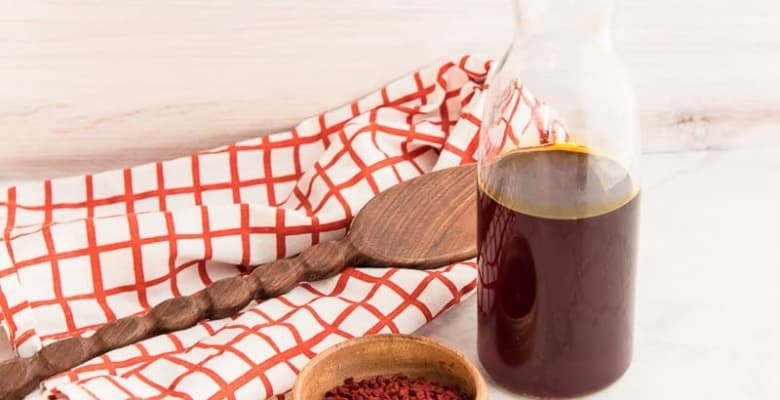
How to Make Achiote Oil
at Sense & EdibilityEquipment
- fine-mesh strainer
- sauce pan
- funnel
- glass bottle or carafe for storing
Ingredients
- 1 1/2 cups (370 milliters) olive oil or vegetable oil
- 2 cloves garlic smashed, optional
- 1/2 cup (80 grams) annatto seeds (achiote)
Instructions
Infuse the Achiote Seeds and Garlic in the Oil
- Add the olive or vegetable oil to a 3-quart saucepan. Warm the oil over medium-low heat for 2-3 minutes.
- Add the achiote seeds and garlic (if you're using it) to the pot once the oil is warm. As the oil heats the achiote seeds, little bubbles will surround them. This indicates that the seeds are gently heating and releasing their color and flavor into the oil. Gently heat the achiote seeds for 15-20 minutes.
Steep the Achiote in the Warm Oil
- After 20 minutes, turn the stove off and allow the seeds to steep in the oil for another 10 minutes or longer.
Strain, Bottle, and Store the Achiote Oil for Up to One Year
- To avoid ruining your countertops, put your storage jar into your kitchen sink before pouring the oil into it. After the achiote oil has cooled slightly, strain it through a funnel lined with cheesecloth into a glass bottle.
- Allow the oil to cool completely before covering it tightly with a lid. Store the achiote oil in a cool, dark area of the kitchen or in the pantry for up to a year, maybe longer.
Notes
Swaps and Substitutions or Add-Ins:
- Omit the garlic for a plain achiote oil.
- You can add more flavor to your achiote oil by infusing herbs or spices like bay leaves, oregano, black pepper, or spicy habaneros.
- For Italian flavored achiote oil: add basil, thyme, or marjoram.
- To enhance your Indian cuisines: add cardamom, cumin, and/or a garam masala combo.
- For Asian dishes: infuse the achiote oil with ginger, garlic, and gochugaru.
- Replace the olive oil with vegetable oil, canola oil, or peanut oil.
- You can double or even triple the quantities of oil and seeds as needed. This is especially helpful if you want to make a lot of achiote oil.
Tips and Techniques:
- Oils like flaxseed, walnut, pumpkin, or sesame have prominent, unique flavors that don't allow the achiote flavor to shine through, so avoid using these.
- Annatto seeds take on an acrid flavor if cooked too long or at too high a temperature.
- Glass is the best storage container for achiote oil since it doesn't stain as plastic does.
- Achiote oil stains easily and permanently, so handle it carefully when straining, pouring, and using it in your recipes.
- Avoid exposing achiote oil to extreme temperatures that will cause the oil to heat or cool dramatically since it will change the oil's molecular structure and flavor.
- Replace the oil in your meat or poultry marinades with achiote oil to add more color to the recipe.
- You can use achiote oil to sauté your vegetables and give them more color.
- Pan-fry your home fries or eggs for breakfast in it to impart color and a nutty flavor.

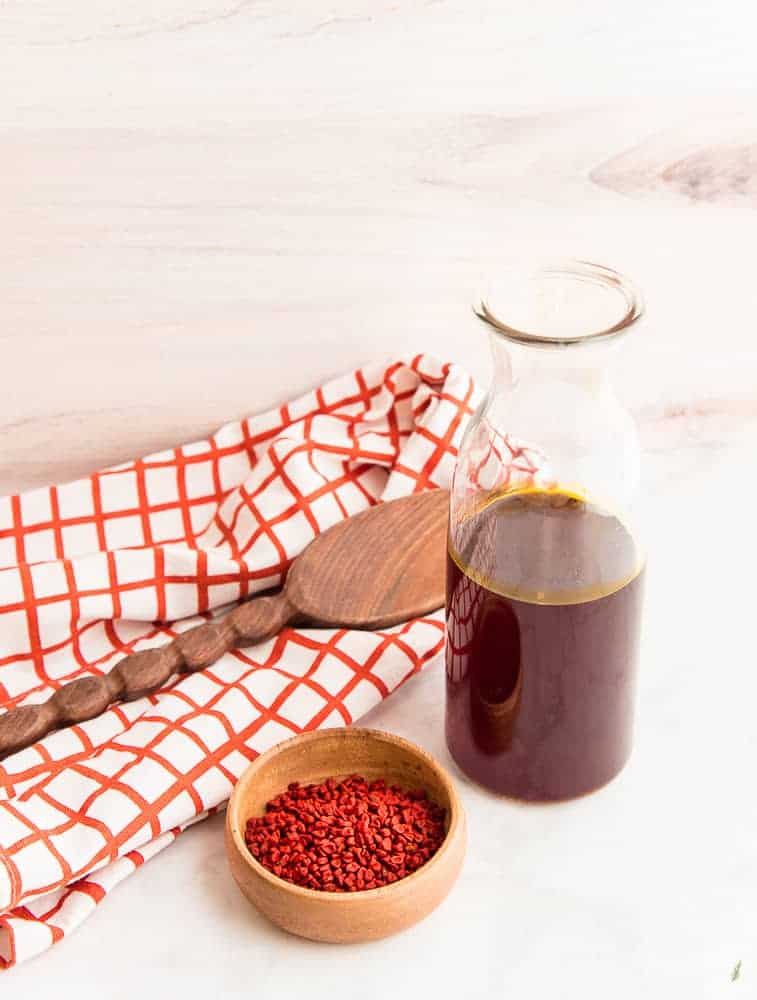
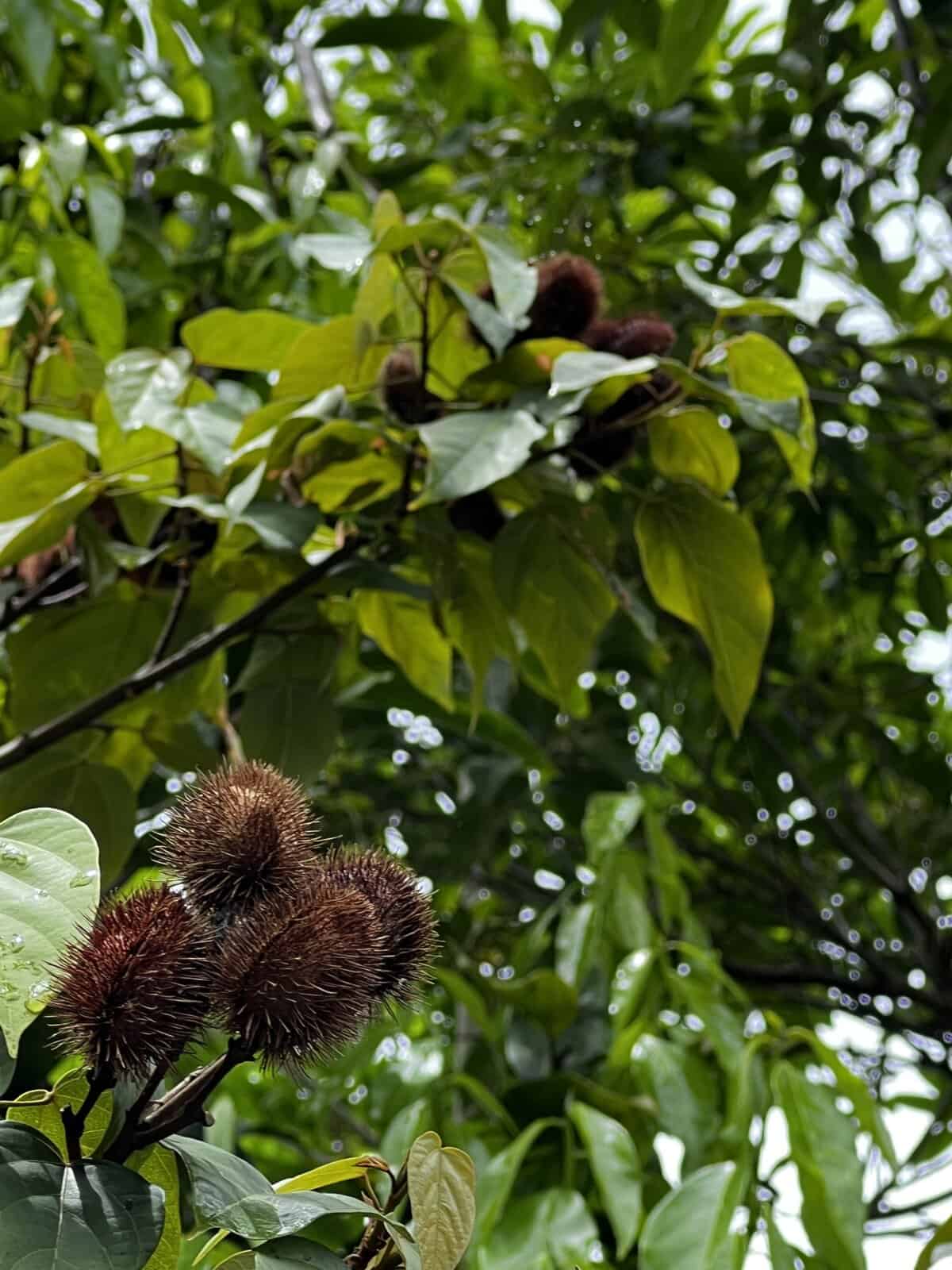
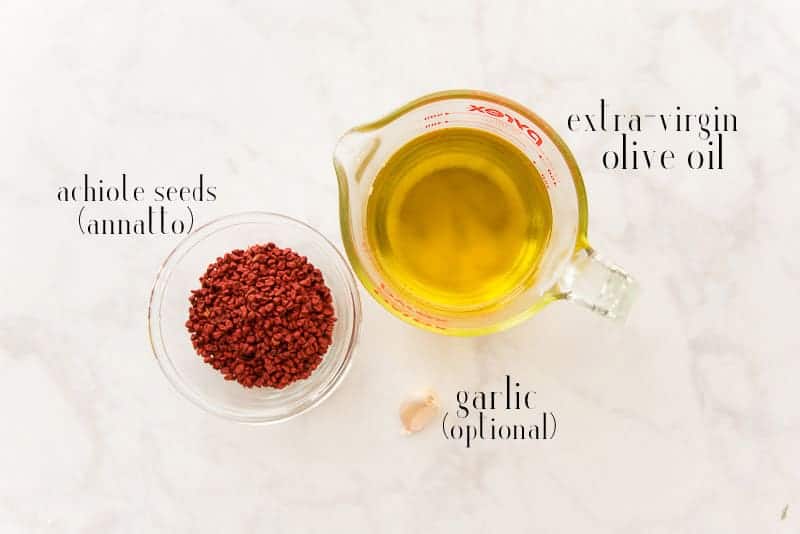
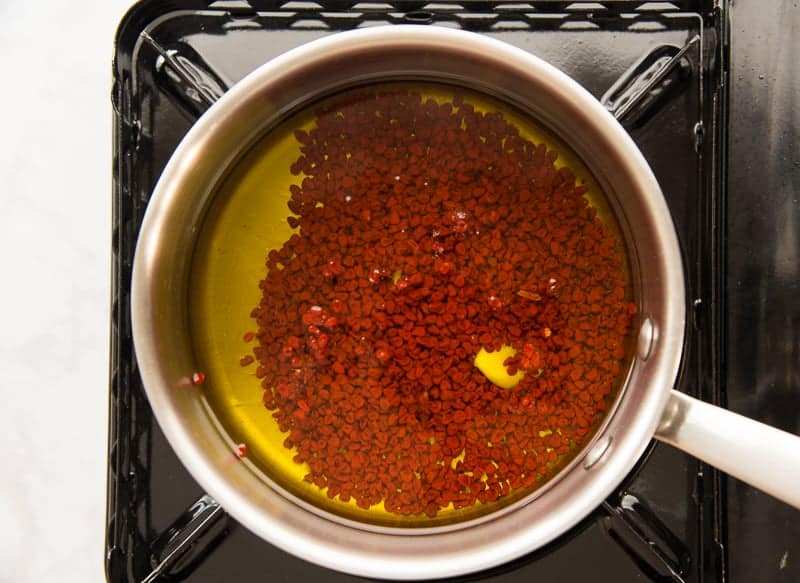
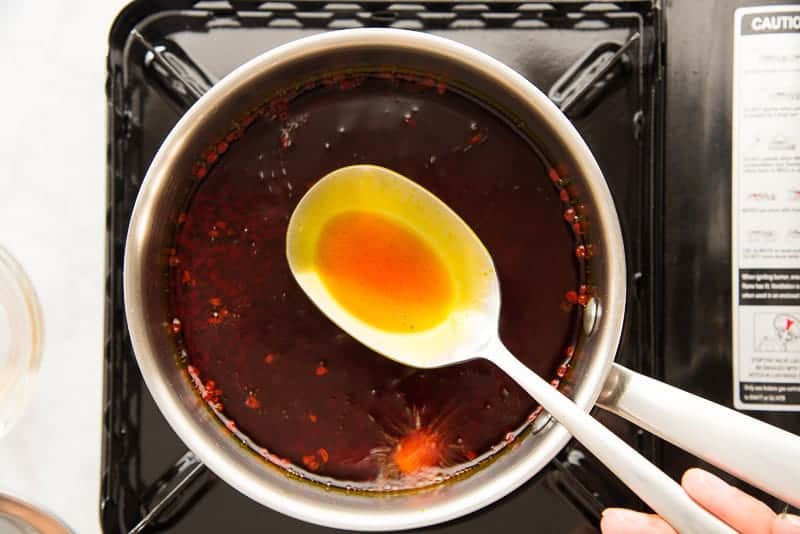
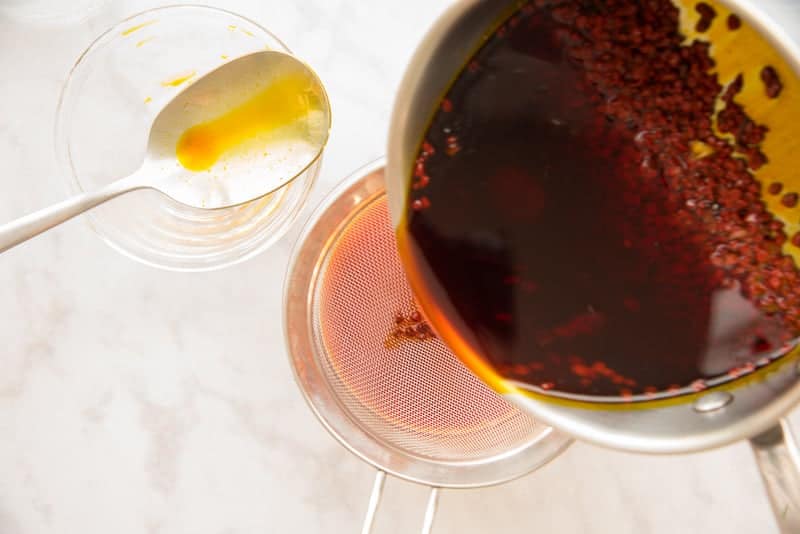

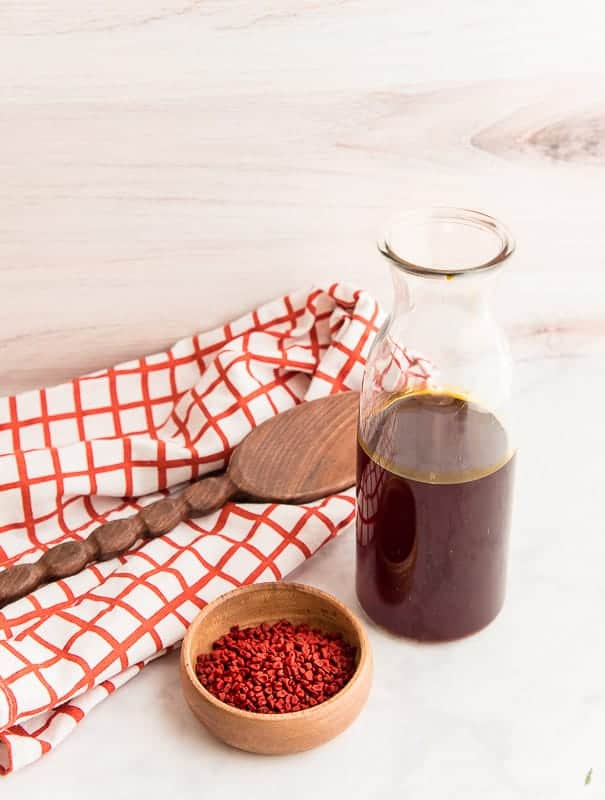
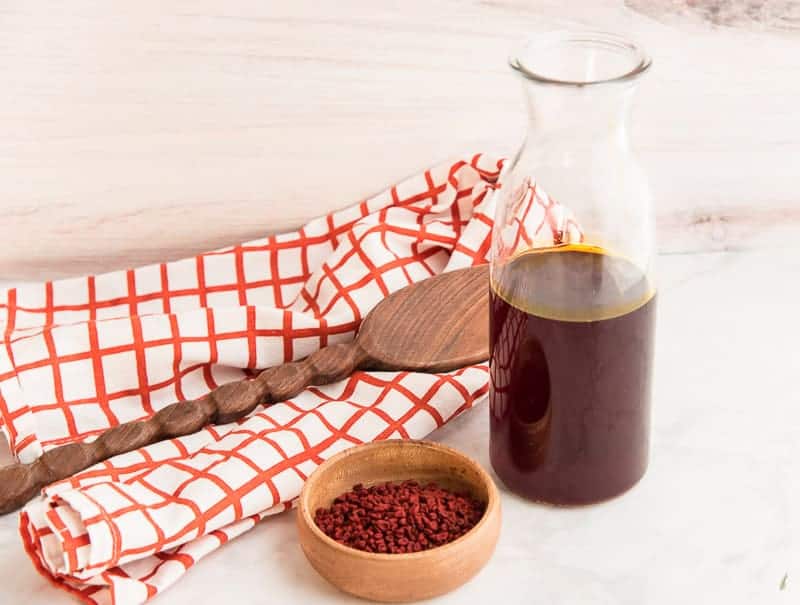





In Trinidad, we infuse water with roucou (annatto seeds) and mix the resulting liquid with salt to make an extract.
Interesting! I love hearing the different ways annatto is used!
l mess up and bought ground annatto. Can i use it to make the oil?
George,
You can add 1 tbsp of ground annatto to 1 cup of warm oil, then let it steep with the stove turned off. You’ll have to strain it to remove the annatto powder before you use it.